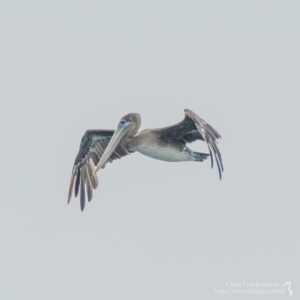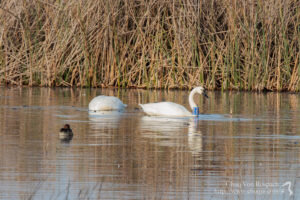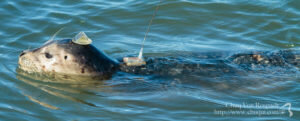Finding and reporting Banded Brown Pelicans (and other birds)
 One of the things I keep an eye out for when I'm in the field birdwatching or doing photography are tagged birds. I typically find one or two a year, although I once had four.Why? Those tags are part of research programs for people trying to study and understand what these birds are doing, where they travel and how the species are doing.Some of these studies are done by scientists in the field trapping and banding birds using mist nets or cannon nets. Sometimes birds are banded as chicks in the nest, which often happens with urban peregrine falcons -- a thankless job for the researcher since the parents are usually trying to kill him during the banding. The other common way birds get banded is when they are injured or ill and rescued; when they are released after recovery they're often banded so the rescue organization can get some data on how well the released birds survive over time.One of the groups doing this kind of research is International Bird Rescue, one of the organizations I've supported with donations over the last few years. They are studying brown pelicans that have been rescued, rehabilitated and released. These birds all have a bright blue leg band on them with bright white letters.
One of the things I keep an eye out for when I'm in the field birdwatching or doing photography are tagged birds. I typically find one or two a year, although I once had four.Why? Those tags are part of research programs for people trying to study and understand what these birds are doing, where they travel and how the species are doing.Some of these studies are done by scientists in the field trapping and banding birds using mist nets or cannon nets. Sometimes birds are banded as chicks in the nest, which often happens with urban peregrine falcons -- a thankless job for the researcher since the parents are usually trying to kill him during the banding. The other common way birds get banded is when they are injured or ill and rescued; when they are released after recovery they're often banded so the rescue organization can get some data on how well the released birds survive over time.One of the groups doing this kind of research is International Bird Rescue, one of the organizations I've supported with donations over the last few years. They are studying brown pelicans that have been rescued, rehabilitated and released. These birds all have a bright blue leg band on them with bright white letters. If you find a banded bird in your wanderings and can get the band number (or a partial number), I want to encourage you to report it. A good starting point for this is the Bird Band reporting page which is supported by the USGS and the Fish and Wildlife Service. It's a clearing house that forwards band reports to the researchers that were issued those band numbers, so you don't have to track down who's studying that bird. In some cases, like the Pelican Project, there are reporting sites you can use instead, but going through the banding page will get the data there if you don't know of a better way to report it.As it turns out I ran into one of those birds on a recent trip to Moss Landing and got a picture of it, which let me identify it as N44. I reported it and included a copy of the picture with the band number visible, and I reported it in.They just sent me the details on the bird. It was rescued in November of 2016 in Goleta as an oiled bird, which means it had run into oil on the water which had penetrated the feathers. This is dangerous (and often fatal) to birds because the feathers lose their insulation value, leading to hypothermia in the cold water.The oil was not from a leak, but from one of the natural seepages that exist in areas with oil deposits. Sometimes these seepages also come from sunken ships, which is why you'll occasionally see efforts to raise or drain the tanks of these sunken ships.The bird was rehabbed in their Southern California center in San Pedro and released in San Pedro right around the end of 2016. My sighting was the first report of the bird since release, and it has travelled from San Pedro to Moss Landing during that time. It's nice for them to hear their rehab efforts were successful and the bird is happy and healthy here in Northern California.
If you find a banded bird in your wanderings and can get the band number (or a partial number), I want to encourage you to report it. A good starting point for this is the Bird Band reporting page which is supported by the USGS and the Fish and Wildlife Service. It's a clearing house that forwards band reports to the researchers that were issued those band numbers, so you don't have to track down who's studying that bird. In some cases, like the Pelican Project, there are reporting sites you can use instead, but going through the banding page will get the data there if you don't know of a better way to report it.As it turns out I ran into one of those birds on a recent trip to Moss Landing and got a picture of it, which let me identify it as N44. I reported it and included a copy of the picture with the band number visible, and I reported it in.They just sent me the details on the bird. It was rescued in November of 2016 in Goleta as an oiled bird, which means it had run into oil on the water which had penetrated the feathers. This is dangerous (and often fatal) to birds because the feathers lose their insulation value, leading to hypothermia in the cold water.The oil was not from a leak, but from one of the natural seepages that exist in areas with oil deposits. Sometimes these seepages also come from sunken ships, which is why you'll occasionally see efforts to raise or drain the tanks of these sunken ships.The bird was rehabbed in their Southern California center in San Pedro and released in San Pedro right around the end of 2016. My sighting was the first report of the bird since release, and it has travelled from San Pedro to Moss Landing during that time. It's nice for them to hear their rehab efforts were successful and the bird is happy and healthy here in Northern California. This kind of data is useful to them because it helps them understand how successful those rehab efforts are and what kind of injuries and recoveries are likely to be successful. One of the blue band birds was recently found down in Mexico sitting on a nest incubating eggs, which is truly a success story.Note: sometimes it can take time for a researcher to reply, and sometimes you never hear back, but I've almost always gotten at least a thank you from the research team for reporting the data to them.My strangest banding report? Again at Moss Landing, I ran into this Harbor Seal that looked something like a robot. It turned out to be a rescue and release from the http://www.marinemammalcenter.org in Marin County (which is another organization I happily donate to). He had been recently released in the Marin area and had made his way down to Moss Landing. The antenna allows them to track the animal with direction finding radio gear, and the markings and radios will fall off after a period of time and they don't impact the animal other than acting as a fashion statement.Interesting trivia point: before researchers can start banding birds and animals like that, the banding techniques have gone through their own studies to make sure the bands don't impact the animal or reduce their ability to survive. All of these techniques have been created to make sure the animals being studied can carry on their lives without discomfort or an increased risk of dying.Over the years I've reported in over a dozen bands, most often the winter migrants because of the time I spend out in the wildlife refuges in the winter, but it's also included other species including White-Crowned Sparrows -- and that Harbor Seal. It's fun, it's a bit of citizen science you can do to help better understand the birds and animals you care about, and it's easy and doesn't take much time and effort -- and the researches really appreciate it when you do it.Getting the full band ID isn't always easy, so I have a number of bands that I could only identify to band type and species. Reporting that can also be helpful, even if your information is incomplete, so I try to send that along whenever it seems to make sense. Some smaller birds (like the sparrows) aren't banded with numbered bands, but with a series of colored bands where the color patterns will tell the researcher where and when they were banded, but not a specific individual. In the case of the sparrow I found, he had been banded about a mile from where I found him two years previously as a chick.So if you're a birdwatcher or nature photographer keep an eye out for banded birds. I typically try to get a sharp photo of any banded bird I see in the field, but I also take shots of flocks and large groupings of birds or animals so I can go home and look at them magnified on the computer later to find bands. About half of the bands I find I don't know about until later on the computer.It's a way to help the people trying to help the birds and animals you care about, and it can be a fun challenge to set yourself -- and I enjoy finding out more about them when I hear back about the researchers and get some info on the bird and the kind of research being done.
This kind of data is useful to them because it helps them understand how successful those rehab efforts are and what kind of injuries and recoveries are likely to be successful. One of the blue band birds was recently found down in Mexico sitting on a nest incubating eggs, which is truly a success story.Note: sometimes it can take time for a researcher to reply, and sometimes you never hear back, but I've almost always gotten at least a thank you from the research team for reporting the data to them.My strangest banding report? Again at Moss Landing, I ran into this Harbor Seal that looked something like a robot. It turned out to be a rescue and release from the http://www.marinemammalcenter.org in Marin County (which is another organization I happily donate to). He had been recently released in the Marin area and had made his way down to Moss Landing. The antenna allows them to track the animal with direction finding radio gear, and the markings and radios will fall off after a period of time and they don't impact the animal other than acting as a fashion statement.Interesting trivia point: before researchers can start banding birds and animals like that, the banding techniques have gone through their own studies to make sure the bands don't impact the animal or reduce their ability to survive. All of these techniques have been created to make sure the animals being studied can carry on their lives without discomfort or an increased risk of dying.Over the years I've reported in over a dozen bands, most often the winter migrants because of the time I spend out in the wildlife refuges in the winter, but it's also included other species including White-Crowned Sparrows -- and that Harbor Seal. It's fun, it's a bit of citizen science you can do to help better understand the birds and animals you care about, and it's easy and doesn't take much time and effort -- and the researches really appreciate it when you do it.Getting the full band ID isn't always easy, so I have a number of bands that I could only identify to band type and species. Reporting that can also be helpful, even if your information is incomplete, so I try to send that along whenever it seems to make sense. Some smaller birds (like the sparrows) aren't banded with numbered bands, but with a series of colored bands where the color patterns will tell the researcher where and when they were banded, but not a specific individual. In the case of the sparrow I found, he had been banded about a mile from where I found him two years previously as a chick.So if you're a birdwatcher or nature photographer keep an eye out for banded birds. I typically try to get a sharp photo of any banded bird I see in the field, but I also take shots of flocks and large groupings of birds or animals so I can go home and look at them magnified on the computer later to find bands. About half of the bands I find I don't know about until later on the computer.It's a way to help the people trying to help the birds and animals you care about, and it can be a fun challenge to set yourself -- and I enjoy finding out more about them when I hear back about the researchers and get some info on the bird and the kind of research being done.
